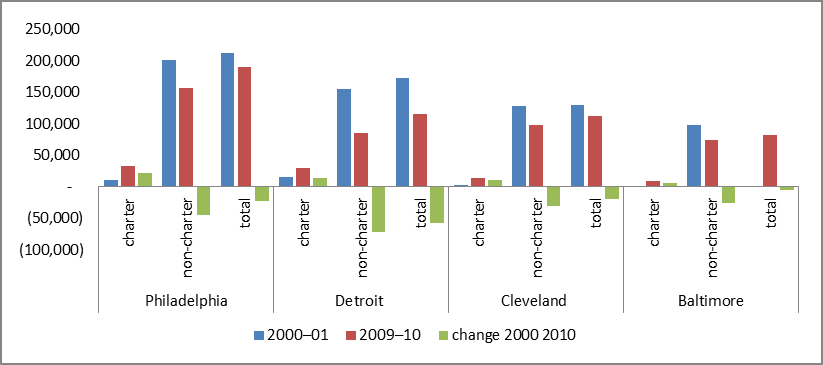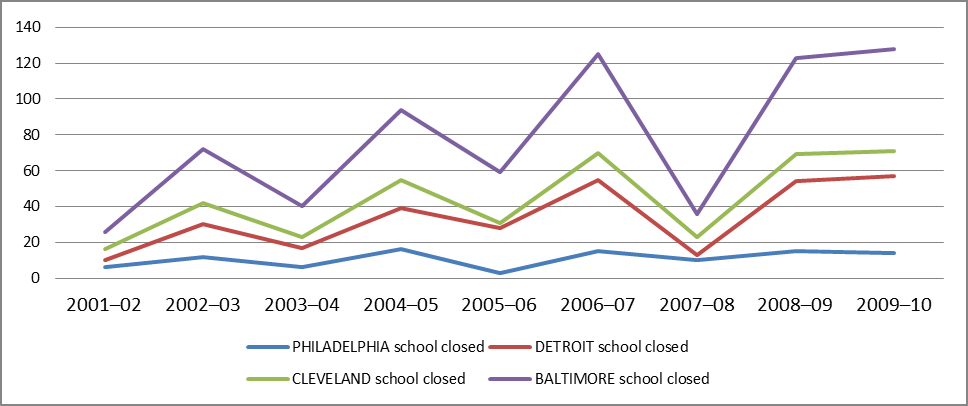Redefining Rustbelt: Opportunities for city revitalization and educational reform
The fourth and final meeting in the Redefining Rust Belt series among the Federal Reserve Banks of Chicago (Detroit branch), Richmond (Baltimore branch), Philadelphia and Cleveland brought together public school superintendents to discuss the central role that quality schools play in making urban communities stronger.1 (For more information on the initiative, please visit Redefining Rust Belt. The role of public schools as institutions in community development is well recognized. Schools employ local residents, impact local housing markets, and influence the aesthetic character of a community (Chung, 2005). The educational system also helps determine the quality of the labor force and, therefore, the health of the local economy (Weiss, 2004). When experts in metropolitan redevelopment are asked what things are most important for metropolitan regions in the United States to be considered "world-class", the issue that consistently tops the lists is having an educated workforce capable of adapting to changes in the economy.
Struggling School Systems and an Increased "Access Gap"
In the cities represented at the final "Redefining Rust Belt" session (Detroit, Philadelphia, Baltimore and Toledo2, superintendents spoke of common longstanding challenges to their school systems. Each has wrestled with financial instability, declining enrollment, and uneven educational opportunities across their districts. An emergency financial manager has led Detroit public schools since 2009. Each of the cities has had to close buildings due largely to the migration of students to charter and suburban schools. On average, about 65 percent of students graduate in four years from these school systems, according to the superintendents. Among male Latino and black students, fewer than half graduate in four years. (See Chart 1 showing trends in the number of students enrolled by charter and non-charter schools).
1. Student enrollment

Superintendents report a talent gap in the classroom as well. Urban settings tend to be places with the most job openings, but they are often the places with the most challenging environments in which to teach. Some of the school districts rely on recruits from Teach for America to fill these positions, requesting hundreds of teachers per year. But superintendents also recognize the importance of teachers having years of experience in difficult classrooms. What is missing, according to the superintendents, are "prep" programs designed to give new teachers apprenticeship opportunities to build an effective inventory of interventions from which to troubleshoot, regardless of where teachers are placed.
More generally, there is an "access gap" across different neighborhoods and schools. Every school system represented in the panel has some extremely high-quality schools, but not enough seats exist at those schools to accommodate every student who wants to be there. While some schools may offer college-level courses starting in 9th grade, other schools may not even have an honors class. Open enrollment policies allow students to attend schools outside of their neighborhood boundaries, but students often have no means of transportation to travel farther distances. The gap in resources between different communities affects teachers, curricula and facilities, as well as an untold number of opportunities outside of the classroom.
An additional challenge to neighborhood stability comes with the closure of school buildings. Half of Detroit's public schools were closed between 2011 and 2014. Philadelphia closed 31 schools over an 18 month period. The closing of school buildings constitute one of the biggest sources of blight across neighborhoods (see Chart 2).
2. School closings

Responding to Challenges
School systems are attempting to address these challenges in a variety of ways.
Attract quality teachers:
Districts are rethinking the opportunities for high-performing teachers, developing housing for new teachers who come into a district, and attempting to brand their localities as exciting places to work for people interested in teaching in the K-12 environment. School systems are looking to provide employer-assisted housing not just for teachers but for other talent related to the education sector as well. Another approach to retain the most qualified teachers has been to suspend teacher seniority rules. One school district recently filed a petition with the state Supreme Court to get clarification of the School Reform Commission's powers in this regard. According to the superintendents, the goal is to bring and retain the most talented teachers for the benefit of schools that need the most support. Schools are also looking to reinforce relationships between teachers and students. One district eliminated the grade 6 through 8 middle school institution and instead created a K-8 environment in all schools. The same district started a program to bus fifth and sixth grade students to high school for music and band/orchestra, and seventh and eighth graders to high school for advanced credit, so that these elementary school students develop relationships with teachers in high schools they will eventually attend.
Provide a unique educational experience and ease the transition to higher education:
School systems are looking to adopt models that provide students with unique educational opportunities. These include project-based schools where the curricula focus on real-world problem-solving in their communities, and school "boutiques" that specialize around the types of industries in which students want to work. School districts are also seeking to build support for students transitioning from high school to community college. One superintendent reported offering courses for credit at the community college. Another district has instituted a pilot program for high school seniors to take the same remedial courses in math, English and writing that they are often required to take during their first years of community college. The purpose is to make it easier for students to pursue a two-year degree, prevent them from getting lost when leaving high school, and lessening the need for financial aid for courses that do not count for credit. An increasing number of external institutions are also helping to develop learning environments that create a continuum between classrooms and industry. The Toledo school system hired someone from the Chamber of Commerce to act as a liaison between industry and classroom for the industries that are looking to connect with high-school graduates. In Philadelphia, the superintendent's department has an office of strategic partnerships that operates as a point of entry for individuals, businesses, philanthropies, and others to support the work that schools are doing. Detroit has full-time staff to manage the entities interested in getting involved with the school system.
Improve quality of life through repurposed school buildings:
School districts are using many of the closed school buildings to improve the quality of life and the quality of neighborhoods for people who live in the surrounding communities. In 2013, the Detroit school system selected 21 sites to serve as "community schools" that house programs such as job skills training, child/elder care, financial literacy and other programs that are offered beyond the traditional school day.3 The Detroit mayor is working with school principals to encourage families to move to promising neighborhoods – neighborhoods that have experienced blight but have potential for improvement given their high-quality housing stock. The school systems are looking to convert other unused school buildings into housing for the parents of school-age children, as well as for professionals and businesses in these neighborhoods. Leveraging New Markets Tax Credits and Historic Tax Credits, some districts have converted closed schools to senior centers. The Detroit superintendent's office has been working to turn a shuttered high school into a farm and food processing center for school programs and a farmers market (Eastern Market) in downtown Detroit.
Summary and Conclusion
According to the superintendents who participated in the panel discussion, there isn't a one-size-fits-all theory of action to implement reforms. The challenges that schools face stem not only from the classroom but, in many instances, from circumstances that students face at home. School systems, therefore, recognize the need to develop students from early pre-school stages through the K-12 system. Perhaps most importantly, school districts must embrace new approaches. As the superintendents explained, that means on one level, creative reuse of buildings and other assets, sometimes leveraging government funding not traditionally targeted to schools for supportive services, and even converting vacant facilities to housing and other non-educational purposes to avert blight and decay of vacant schools and surrounding neighborhoods. On another level, it means expanding the process of articulation4 from ensuring that coursework in elementary and middle schools prepares students for high school, to familiarizing students with facilities, faculty, and coursework at the high school level, and ultimately strengthening links to and coordination with employers. From a labor standpoint, school districts are also working to broaden measures to attract good teachers, such as providing housing assistance, and placing less emphasis on tenure and more on performance. Economic conditions are forcing school districts to redefine and expand their roles, and take unprecedented steps to ensure their viability while placing primary emphasis on student success.
References
Chung Connie, "Connecting Public Schools to Community Development,"; Available online.
Jonathan D. Weiss, “Public Schools and Economic Development: What the Research Shows,”
Footnotes
1 The meeting took place as a plenary session at the national conference “Reinventing Older Communities” in Philadelphia in May 2014.
2 Detroit was represented by Jack Martin, Emergency Manager of Detroit Public Schools; Philadelphia was represented by William Hite, Superintendent of the School District of Philadelphia; Baltimore was represented by Gregory Thornton, Superintendent of the Milwaukee Public Schools and incoming CEO of Baltimore City Public Schools; and Toledo was represented by Romules Durant, CEO and Superintendent of Toledo Public Schools. Toledo was represented instead of Cleveland in the final meeting of the series. However, all the charts in this blog reference Cleveland for consistency in the project.
3 For more information, see DPS announces 21 schools to serve as “12/7 Community Schools” and hubs of their neighborhoods, available online.
4 Defined by the U.S. Dept. of Education as “systematic coordination of course and/or program content within and between educational institutions to facilitate the continuous and efficient progress of students from grade to grade, school to school, and from school to the working world.”








